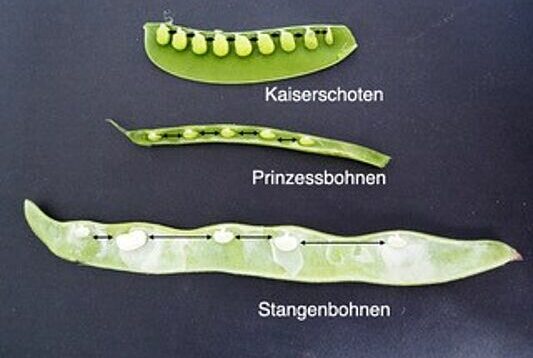An international team of researchers led by biologists from Heinrich Heine University Düsseldorf (HHU) has examined how seed formation is coordinated with fruit growth. In the latest edition of the journal Current Biology, they explain the genetic control mechanisms underlying the process.
If you open up a pea pod, you will find that all of the peas inside are the same size and the same distance apart. The same is true of princess beans, runner beans and soybeans as well as various other peas and beans, and it also applies to non-pulses. This is surprising because both the seed size and number and the pod size differ substantially from one variety to the next.
A team of researchers based in Germany, Australia, Japan, the USA and Italy under the supervision of Prof. Dr. Rüdiger Simon from HHU’s Institute of Developmental Genetics has analysed the genetic mechanisms behind this phenomenon. The team used different wild varieties of thale cress to examine the genetic processes taking place behind the initiation of ovules – the primordia from which seeds emerge after fertilisation – and the growth of the pod. These wild varieties are sourced from different locations. Thale cress or Arabidopsis thaliana is a model plant used in biology. Prof. Simon commented: “The individual seeds compete with each other for nutrients. To ensure that each seed gets an equal supply and can develop well, it is important that the seeds are spread as evenly as possible at equal distances in the pod.”
There is considerable variation in fruit size and seed number even amongst the different wild varieties of Arabidopsis thaliana. However, the researchers also discovered a uniform genetic mechanism that controls seed position in the pod regardless of environmental factors such as temperature.
The team established that seed formation is controlled by several signalling pathways at precisely defined positions. These signalling pathways are activated by small secreted proteins from the EPFL family. These peptides are detected on the cell surface by receptors from the ERECTA family. One of the peptides, EPFL2, is formed between the developing ovules, where it adjusts the spacing between the seeds. Where this peptide is not present, the researchers found irregular spacing – meaning that adjacent seeds compete more for nutrients – or even ovule twinning, which generally results in neither ovule developing fully. EPFL2 and a very closely related peptide, EPFL9, also control fruit development. As a result, seed formation is closely linked to pod growth.
Dr. Nozomi Kawamoto, the first author of the study, highlighted another aspect: “The same signalling substances and receptors that we have identified as being responsible for relative pod size and seed spacing are also in charge of the spacing of leaf stomata and the microstructure of serrated leaves.” A plant uses the stomata to regulate the exchange of gases with its environment. Dr. Kawamoto is carrying out post-doctoral research at Prof. Simon’s Institute as part of the Cluster of Excellence on Plant Sciences CEPLAS in Düsseldorf.
Read the paper: Current Biology
Article source: Heinrich Heine University Düsseldorf (HHU)
Image: Seeds in different bean and pea pods. The research team has clarified why the spacing between the seeds is so similar in each pod and how the spacing relates to fruit size. Credit: HHU / Nozomi Kawamoto








